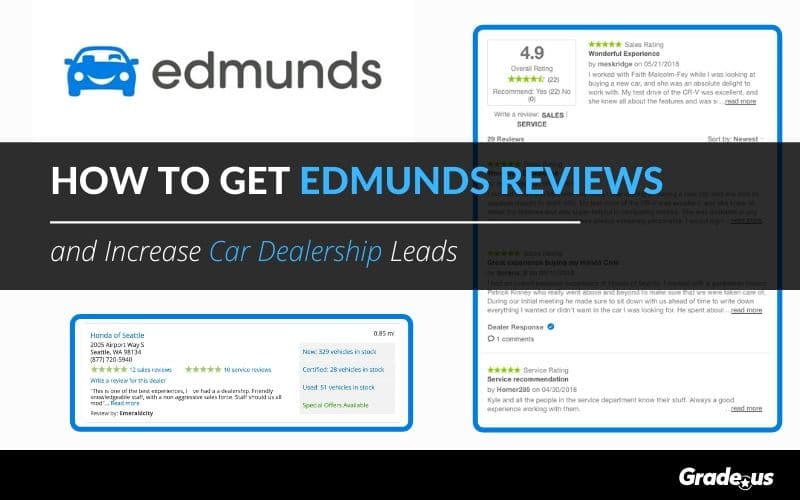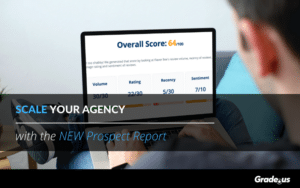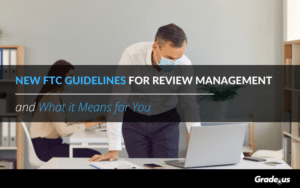Edmunds has a sterling reputation. You better believe that if you know how to get Edmunds reviews for your car dealership, you’re going to differentiate yourself from the competition.
According to a study from Maritz Research, Edmunds was listed as the fourth most trusted review site. Originally, they were an automotive publishing company. Now they’re viewed, by many, as the gold standard in the automotive industry.
The automotive giant receives an estimated 15.5 million visitors annually. According to Owler, Edmunds brings in an estimated $250 million each year. If you’re running or managing a dealership located in the United States, you should be on Edmunds.
Today we’ll cover:
- Why Edmunds is important to your dealership
- Who visits Edmunds?
- How Edmunds compares to other review platforms
- What your goals should be on Edmunds
- Claiming or creating a dealer page on Edmunds
- Tracking and responding to reviews on Edmunds
- Promoting your Edmunds reviews
- Your Edmunds point-of-contact
- Goal tracking via Edmunds
- Advertising and review marketing on Edmunds
Why Edmunds is important to your dealership
Edmunds works to protect consumers, providing them with price comparisons, vehicle and dealership reviews. They publish exposés exposing the unsavory parts of the car buying process. They rank, appraise and test vehicles, enabling consumers to browse dealer inventories, get shopping tips, read feature stories and more.
It’s really about trust.
A survey by Gallup found that 56 percent of Americans have a positive view of the automotive industry, specifically auto manufacturers. The 2019 Edelman trust barometer confirms Gallup’s findings. As I said, these findings are focused on manufacturers, not dealerships.
Okay, what about dealerships?
Customers don’t have the same positive feelings about dealerships.
- A recent survey found 87% of consumers dislike the dealership experience
- 61% of respondents felt they were taken advantage of by their dealership at some point
- 52% of buyers feel anxious or uncomfortable at dealerships
- 24% stated they'd rather have a root canal than negotiate for a car
- An AutoTrader study found 45% prefer to be anonymous to the dealer until they lock in a deal
- 56% of buyers want to negotiate the price; they don't trust flat-rate pricing
You’re probably already familiar with these figures. What’s not clear is how Edmunds factors into the equation. How can their platform boost the traffic, footfalls and leads to your dealership?
Let’s take a look at the data.
- According to the automotive buyer influence study, the Internet is 20 times more influential than any other media source (online or offline).
- 56% of car buyers say third-party sites (e.g., Edmunds, Kelly Blue Book, Cars.com, etc.) are the most useful sites - 3x more than any other site.
- Car buyers say third-party sites, manufacturer sites, dealer sites and search engines complement each other during the shopping process.
- A Facebook/Accenture study found 63% of car buyers discovered new vehicles online.
- 78% of the car buyers surveyed agreed that it’s important for the purchase of a vehicle to be as easy and convenient as possible.
- When it comes to reviews, an automotive report by DMA found there are either no reviews or, what is available lacks credibility. A quick glance at Edmunds.com confirms these findings.
- 68% agree that they rely on customer reviews to make informed decisions. Increasingly the customers’ voice is more trusted than a brand’s reputation.
- 38% of women surveyed said a recommendation from a friend or family would make them interested in buying an automobile brand they had not previously considered.
- A combined 57% of car buyers stated that reading online reviews from other people who have bought the car would be "effective or very effective," encouraging customers to buy a car online without going to a car dealership.
It’s pretty clear now, right?
If you’re a manufacturer, customers are already searching for your dealership online.
Wait a minute.
What if customers are looking to buy a specific make or model? The argument for using platforms like Edmunds becomes even stronger. Dealerships specialize, they focus on a particular range of makes and models. When customers, who are in the market for a new or used vehicle, search for a brand on your lot, your dealership comes up in Google, kind of like this:
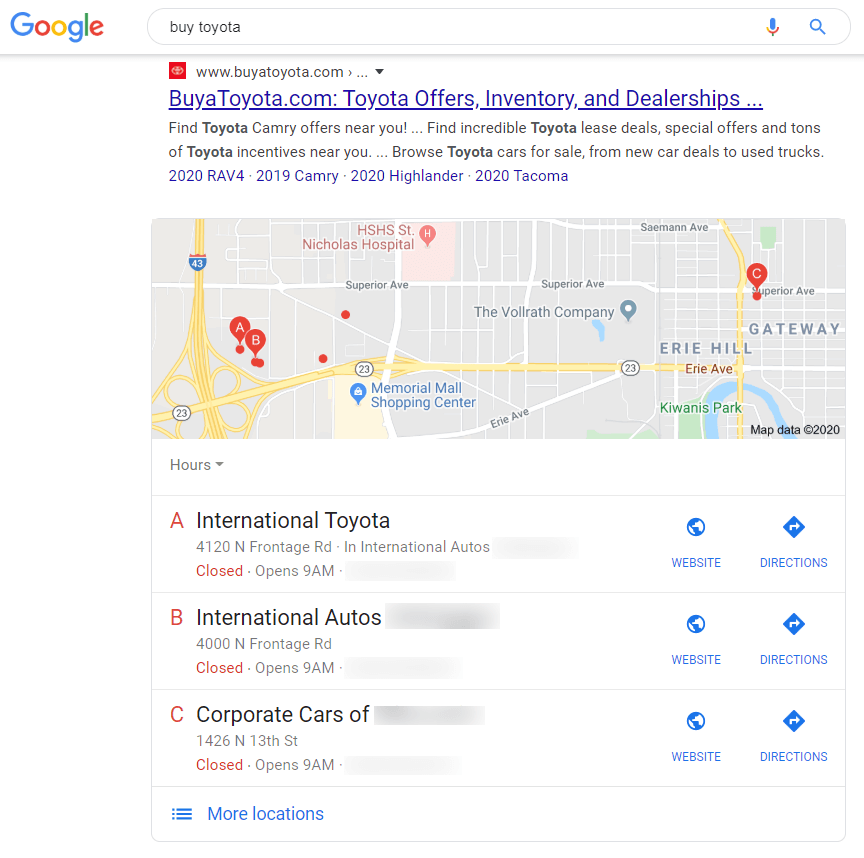
Edmunds has a symbiotic relationship with Google. This makes sense when you realize 57.45% of their traffic comes from Google search (97.08% of that organic vs. 2.92% paid traffic).
What are the user demographics of Edmunds.com?
Who visits Edmunds?
Edmunds users are more affluent, according to their data. Their research shows that:
- 57% of their users are male, 43% are female
- 62% are between the ages of 25 to 54
- 59% have a college or postgraduate degree
- 91% on their own home
- 62% are employed full-time
- 79% are married
- Edmunds.com is the #1 auto site for consumers who make $100K+
- Edmunds.com is the #1 auto site for consumers with investment portfolios of $250,000+
- 35% of Edmunds sessions are shoppers in the market for a new car
- 50% are shoppers in the market for a used car, roughly mirroring the new-used sales breakdown
- Over 70% of Edmunds visitors research a specific vehicle, examining pricing, reviews, features and specs, photos, and other details
The data indicates that Edmunds users are educated and discerning buyers. How do we know? Edmunds’ audience skews affluent, with 61% of Edmunds visitors from households earning over $75,000 per year, compared to just 36% of the U.S. population. Higher-income generally translates into a better ability to afford a new car and to qualify for financing. They’re careful shoppers who are more concerned with the overall value, quality and experience associated with their purchase.
Here’s another surprising detail.
“Edmunds’ audience also skews Millennial, the large up-and-coming generation aged roughly 18-34. According to Google Analytics, 38 percent of Edmunds sessions are by Millennials, compared to just 31 percent of the U.S. population. These visitors are particularly active on Edmunds’ mobile site, accounting for 55 percent of sessions there versus 26 percent of wired site sessions. For dealers interested in attracting these car buyers of the future, a third-party site is a good place to reach them.”
What does this mean for car dealerships like yours?
Edmunds users understand the power of online reviews. What about the other online review platforms (e.g., TripAdvisor, Yelp, Google reviews)? Aren’t these review platforms just as, if not more important than Edmunds? There’s a faulty assumption hidden in the question.
It’s not an either-or proposition.
When shoppers are in the market for a new vehicle, they don’t rely on a single third-party platform. They rely on multiple platforms. Customers today are focused on the third-party providers who have information on their preferred dealerships. Customers will visit Edmunds, Yelp, Google, Cars.com and a plethora of other third-party sites to dig up crucial information on your dealership.
For consumers, it’s all of the above.
How Edmunds compares to other review sites
With that in mind, let’s take a look at how Edmunds compares to the big three (e.g., Yelp, Facebook and Google).
Wow, that’s quite a difference!
It’s no surprise Edmunds is a small fish compared to the big three. As we’ve seen, educated or affluent customers who are in the market for a new vehicle focus their attention on Edmunds. They’re a niche provider with a very large core audience.
What does this mean for dealerships?
You’ll need to focus your attention on specialty providers like Edmunds and big three platforms like Google or Yelp reviews. It’s not one or the other; you need them all.
Business goals for brands on Facebook
- Branding and reputation: Your reputation on Edmunds carries a significant amount of weight. Here's the problem. You can be affected by both the reviews on the makes and models you carry as well as reviews of your dealership. Remember the stat I mentioned earlier? 57% of car buyers felt online reviews would be enough to sway their decision one way or the other.
- Footfalls: Offline customer foot traffic from Edmunds, driven directly to your physical location. This could be customers visiting your business for the first time to get a sense of what you're about. It could be customers stopping by to do some comparison shopping. Maybe they're stopping in to request a test drive or buy a specific vehicle they've negotiated online.
- Leads: The contact info from motivated prospects, customers who are both willing and able to buy. On Edmunds, this means you'll receive your prospect's first and last name, email and phone number. Competing dealerships will also receive your prospect's information.
- Online visits: This refers to traffic from your Edmunds page that's driven to your vehicle detail page (VDP). Achieving conversions with these VDPs requires (a.) relevancy first and foremost; if customers don't see the vehicle they've requested from Edmunds on your VDP they're gone (b.) a variety of communication channels (e.g., email, chat, text, Facebook Messenger, etc.) for prospects that want more information. (c.) an overarching and compelling reason for prospects to share their contact information. You'll want to track this with tools like Google Analytics.
- Sales: This is customer derived cash flow which is pretty straightforward. You provide customers with the outcomes (a new or used vehicle at favorable terms) they're looking for in exchange for money. A strong review portfolio directly correlates to increased sales and revenue.
Now that we’ve discussed appropriate goals for dealers on Edmunds, we’re ready for the next step.
Claiming or creating a dealer page on Edmunds
There’s a good chance your dealership is already listed on Edmunds. If it isn’t, you’ll need to go through Edmunds’ registration process. Edmunds has a platform called CarCode that enables dealers to manage their on-site dealer pages.
Here’s how you sign up.
1. Visit Edmunds.com/industry. Click on Products and Solutions, then click on one of the following: New Car Dealers, Used+ Car Dealers, OEMs

2. Scroll to the bottom of the page; then, in the contact form displayed, enter your contact information. Click submit to send your information. You’ll be provided with a one-sheet, and an Edmunds representative will contact you to get the process started.
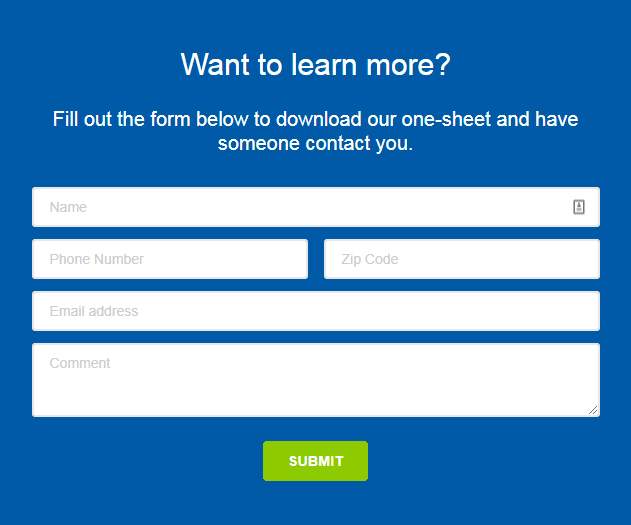
3. You’ll be given access to CarCode once you’ve registered as a dealer on Edmunds.
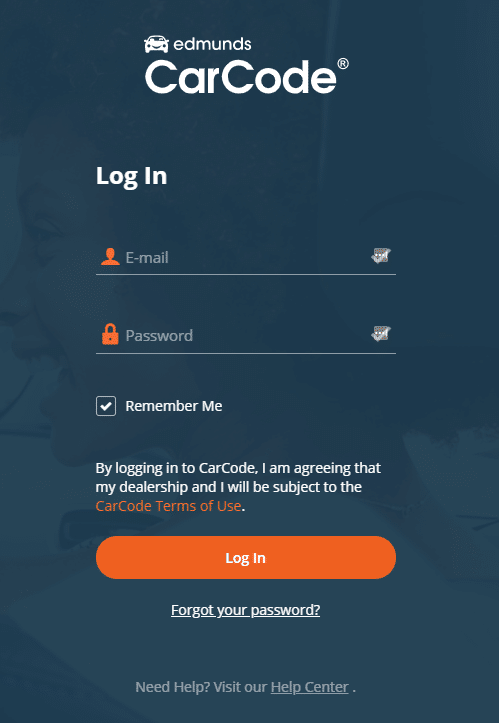
4. Once you have access to CarCode, you should be able to edit your sales, widget and general settings. These settings enable you to edit your dealer page, set hours of operation, respond to customers and more. Here’s a brief demo/primer of each.
Here’s a walkthrough of CarCode’s sales settings:
In CarCode, you’re able to access sales, widget and general settings.
Sales settings include:
- Voice call settings and greetings
- SMS settings (including auto-replies)
- Lead assignment rules
- CRM email settings
- Dealership hours settings
Here’s a walkthrough of CarCode’s widget settings:
Widget settings include:
- Your embed code
- A testing tool to verify the widget is working as expected
- Previewing widgets
- Creating new widgets
- Configuring widgets
- A list of active/inactive widgets
Here’s a walkthrough of CarCode’s general settings:
General settings include:
- Dealership address
- Dealership time zone
- External links
- Dealership features
Using Edmunds’ CarCode, you can also communicate with customers directly via email, chat or text.
Edmunds’ CarCode is simple and intuitive, making it easy to manage the content on your dealer page. This app is also how you optimize your dealer page on Edmunds. Completing your profile, making sure your name, address and phone number are correct.
Tracking and responding to reviews on Edmunds
The team at Edmunds made a surprising discovery.
They analyzed dealer reviews posted over a period of 30 days and found that 90 percent of the reviews were focused on either the sales or service departments. The most common title for any review on their platform was “Great Experience.“
They listed some telltale indicators from customer reviews.
- No-pressure, didn't feel rushed
- Trustworthy
- They listened to me
- Quick and painless — the dealership made the process easy
- Quick and clear communication (email or in-person)
- No games
- Final price was exactly as negotiated (no last-minute surprises)
- Professional and polite salesperson
- Attentive to customer's needs
- Salesperson went above & beyond — locating a specific vehicle, delivering vehicle to customer, staying after hours, etc.
See the common thread?
Customers are focused primarily on their experience. Many of them had unpleasant experiences with other dealerships. These poor experiences inform their expectations with you. At first glance, this sounds like a significant downside.
It’s actually the opposite.
The good things you do (Edmunds describes them as “the little extras”) make a significant impact on customers. These experiences work to reshape their perceptions of car dealerships in general and your dealership specifically. This increases the likelihood that these happy and satisfied customers will leave a positive review once their purchase is complete.
How do car dealer reviews work on Edmunds?
Dealers receive a star rating on Edmunds. According to their site, your overall star rating is an aggregate of all the reviews posted on your dealer page for the last two years. Here’s how Edmunds explains it:
“Your overall star rating is aggregated from all reviews posted in the last two years — specifically, beginning from the first day of the current month going backward to the same date two years ago. For example, if today’s date is 10/1/2018, the stars include all reviews from 10/1/2016 to today. Once a review is over two years old, its rating is no longer reflected in the overall star rating.”
This means it’s important to continue to ask customers to share their feedback. Reviews on your profile are valuable but they do have a limited shelf life.
Here’s another important point.
You may have noticed that review management wasn’t a part of Edmunds’ CarCode back end. That’s by design; the Edmunds team prefers to reduce the number of barriers preventing customers from sharing genuine feedback. If you’d like to respond to a customer review on behalf of your dealership, it’s simple and easy.
“No registration is required in order to respond to your reviews. Simply select a display name that represents you or your dealership, enter a valid email address, and the text of your comment.”
That’s great news, right?
Not so fast. What if someone is dishonestly claiming to represent your dealership and responding to customer reviews? What if they post an inflammatory or inappropriate response?
“We review all comments posted to ensure validity. However, if you find a comment in response to a review representing the dealership that you believe was not posted by the dealership, click the ‘Report it’ link beneath the comment, and our Reviews Team will investigate and remove the comment if necessary.”
There it is! Easy peasy, lemon squeezy.
If you’re using a third-party review management platform like Grade.us to manage your reviews, these are details you can monitor automatically.
Start Generating Edmunds.com Reviews Today!
Promoting your Edmunds reviews
I’m a strong proponent of the 60/30/10 paradigm promoted by Perry Marshall and others. If you’re a regular reader, you’re already aware of this strategy.
What’s 60/30/10?
You spend…
- 10% of your budget on Cold traffic. You promote your content to highly targeted groups of prospects who have never heard of you. You provide them with value in the form of a tool, quiz, download or content. No opt-in required. If you're going to lose money in your campaign, you lose it here to gain valuable insights everywhere else. You tag these prospects using Facebook's tracking pixel or via tools like Google's tag manager.
- 30% of your budget on Warm traffic. You run your own ads and ads via Edmunds.com. The prospects you've tagged (see above) who have responded to this second round of advertising are now (a.) warm – they’re familiar with your business and (b.) interested enough in your offer to continue the conversation. Advertising your positive reviews and directing customers to your VDPs (to show off your amazing reviews) is a great way to convert these prospects. This is the relationship-building phase of your campaign.
- 60% of your budget on Hot traffic. These are the prospects who have opted-in (cold), converted and/or engaged with your business (became warm). They're now requesting a quote on your VDPs, which means they're hot prospects. They’re engaged shoppers – they've decided on a particular make or model, are interested, willing and able to buy and are prepared to buy soon. These prospects have self-identified, showing a clear interest in your product or service. These are the customers you fight for.
Promoting your reviews is incredibly compelling.
Especially if your VDP has premium content (e.g., downloadable brochures, owner’s manuals, crash-test ratings, green scores, awards and accolades) in addition to reviews. These are simple enough for dealers to acquire, but they produce exceptional results. This formula is how you 2x your footfalls, traffic and leads.
EDP + EAR + Premium VDP = 2x return.
Where:
EDP = Edmunds dealer profile
EAR = Edmunds advertising and remarketing
VDP = Premium Vehicle details page
This formula depends on precise targeting, and that’s the difference between mainstream providers like Yelp and specialty or niche providers like Edmunds. The customers on Edmunds are focused on a specific goal: buying a car. Not so on other platforms.
There’s a downside though.
Take prospects directly to your VDP and it’s not quite as compelling, even if you show them the same, exact reviews on your site. Think about it from your customer’s perspective. Of course, you’re going to focus on your positive reviews! Of course, you’re going to talk yourself up. There’s a clear conflict of interest here.
Here’s a better option.
Advertise your reviews, then send them to your dealer page on Edmunds. They’re going to make an immediate beeline for your negative reviews.
That’s what you want.
These customers want to dig up dirt on your dealership. They’re trying to avoid making a mistake after all. What they’ll get instead is a master class on responding to negative reviews. Your factual, kind, honest and transparent responses to negative reviews will strengthen their interest in working with you.
Kind of like this.
First, here’s the customer’s review. Paints a pretty unpleasant picture, doesn’t it?
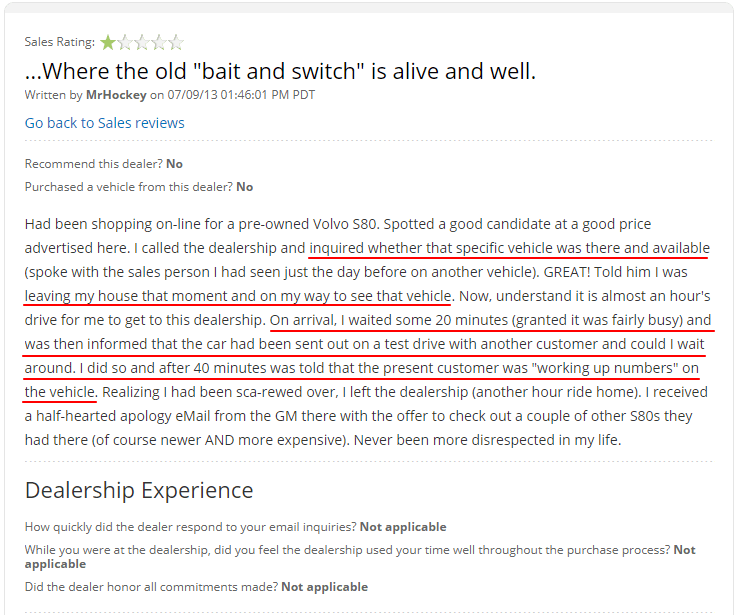
The dealer’s response paints a very different picture.
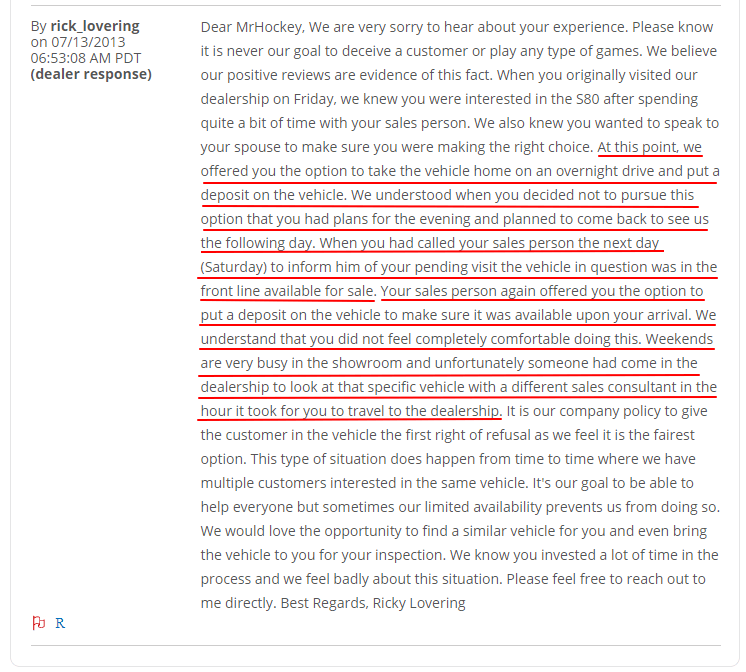
This customer wanted a test drive but they refuse to reserve the specific vehicle they wanted three times. The specificity offered by Rick, the dealer’s representative, shows the dealership made a good-faith effort to honor their word. This kind of outstanding response blunts the impact this negative review would’ve otherwise had on their dealership.
See what I mean?
Sending customers to your dealer pages on these review platforms is powerful because it adds credibility to your dealership. Customers are willing to believe the reviews listed because they’re displayed on a platform you don’t own.
What about your inventory?
You’ll need to work with Edmunds directly (via their advertising programs) to add your inventory to their site. This is something you can discuss with them once you’ve gotten in touch with an Edmunds representative. That’s a good question. How do you get in touch with someone at Edmunds? Is it as difficult as getting in touch with someone from Google or TripAdvisor?
Your Edmunds point-of-contact
If you’re running an advertising campaign on Edmunds, you’ll have access to a dedicated support and social advertising team. They’ll help you manage and optimize your advertising campaigns, providing you with the support you need.
You can email their ad team directly at [email protected].
Here are several methods you can use to contact someone at Edmunds.
As far as dealers are concerned, the direct method is the best and most prudent approach.
Goal tracking via Edmunds
Edmunds, unlike their mainstream providers (e.g., Yelp, Facebook or TripAdvisor), doesn’t offer an in-house analytics solution.
Edmunds recommends Google Analytics instead.
“You can track performance with your own Google Analytics account for complete transparency. Don’t have an account? Our success team will help you set it up, and even establish your goals and KPI benchmarks.”
This isn’t really a surprise as a few of Edmunds’ tools (i.e., Edmunds Trade-in tool) are already compatible with Google Analytics. That’s a win for dealers because it gives them the chance to validate the performance of Edmunds platform using trustworthy, third-party tools.
It’s a win all around, especially if you’re interested in marketing your Edmunds reviews.
Advertising and review marketing on Edmunds
Edmunds has a variety of advertising formats and programs.
Here’s a list of their specifications and their 2019 – 2020 ad products (listed below).
To get started, dealers can fill out the form here or contact [email protected].
What about their policies?
Here’s a shortlist of Edmunds ad guidelines and policies.
- Edmunds reserves the right to review and accept or reject any advertisement that does not meet its ad specifications, including these general ad guidelines and policies and those applicable to the specific ad unit. Out-of-spec requests will be reviewed and approved or rejected on a case-by-case basis.
- All creative assets/elements comprising the ad being served — tags, images, tracking pixels, etc. — must be secure, i.e., be SSL (Secure Sockets Layer) compliant, make secure calls, and use secure URLs (i.e., https, protocol-relative URLs). If non-secure creative is served on our website, it can prompt a warning in the user's browser, cause ad serving problems, or cause the entire page to be blocked.
- Edmunds DOES NOT accept ads in the following formats: commercial break, floating, floating expandable, interstitial, out-of-banner, pop-up, pop-under, reminder, video strip, wallpaper or window ad. Page takeovers and other custom executions will be evaluated on a case-by-case basis.
- Creative assets must not write cookies to the user's computer (including Local Shared Objects, i.e., Flash cookies). By delivering creative assets to Edmunds, the client is representing and warranting that no cookies will be written by such creative assets.
- Edmunds' third and fourth party tracking policies are stated here.
- All creative must function uniformly on both Windows and Mac operating systems, as well as the web browsers Chrome, Firefox, Internet Explorer and Safari.
- Frequency caps are not applied to standard or specialty units.
- All brand logos must be smaller than the Edmunds' logo.
- Except as otherwise permitted by Edmunds in connection with native ad placements, all ads must clearly be differentiated from page content by adding a minimum 1px border or containing a contrasting background color. Edmunds reserves the right to reject any ad using Edmunds' look and feel to mimic in-page content.
- Edmunds reserves the right to reject any ad on behalf of, or which directly promotes Edmunds competitors' sites, products, services or activities.
- Edmunds reserves the right to suspend and request new assets for ads receiving negative consumer feedback.
- While Edmunds often suggests or recommends advertising content to its clients, collaborates with its clients to formulate advertising content, or creates advertising content for its clients — in each case for use on our websites — it is the responsibility of the client to determine if such content (including any "claims") (1) are accurate, (2) comply with all applicable laws and regulations and industry standards and practices, and (3) do not violate the rights, or require the consent of, of any third parties. Edmunds cannot and does not take such responsibility. The only exceptions are advertising claims that are based on Edmunds data or editorial content and as to which the client has obtained the written or emailed approval of Edmunds' Permissions or Legal Department.
These ad products provide you with the tools and resources you need to attract ideal shoppers to your dealership. That’s a significant advantage as the majority of dealerships on Edmunds are not using these tools and products.
Edmunds sterling reputation is your gain
Edmunds is viewed as the gold standard in the automotive industry. Their audience consists of affluent and discerning buyers. Edmunds works to protect consumers, providing them with price comparisons, vehicle and dealership reviews. They publish exposés exposing the unsavory parts of the car buying process.
It’s about trust.
Building trust on Edmunds requires a complete profile, a strong review portfolio and attentive dealer representatives. You can do it. Put Edmunds sterling reputation to work, and eventually, you’ll find their sterling reputation becomes yours.

